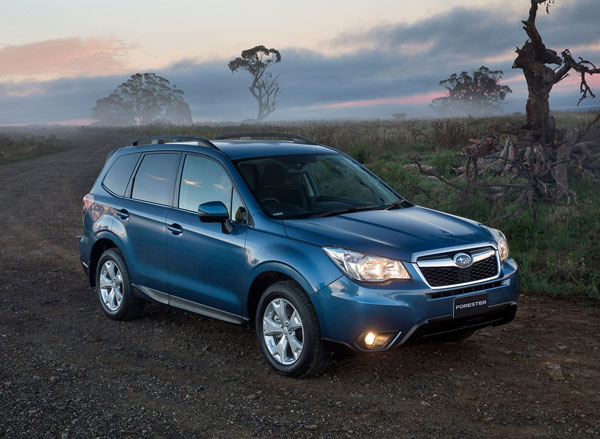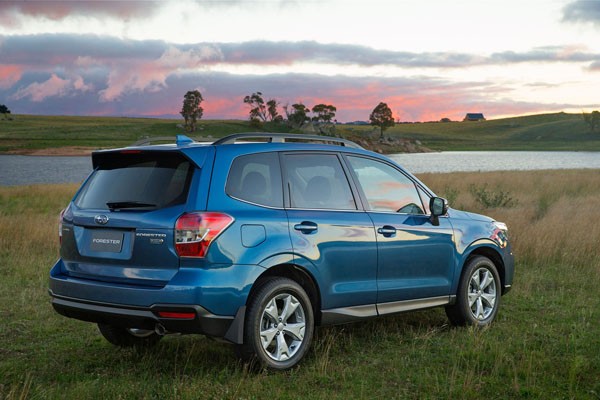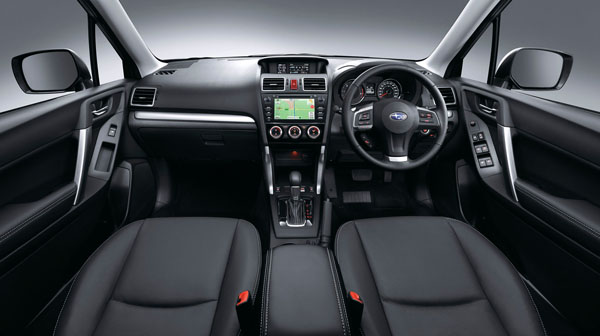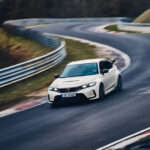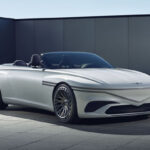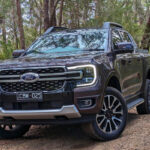The Subaru Forester cocktail has been ‘shaken not stirred’ for 2015, just as James Bond would like it. It’s no secret that this compact sports utility vehicle had suffered at the hands of not having diesel power with an automatic transmission.
Not only has that been rectified, but the gearbox is the latest Subaru Lineartronic continuously variable transmission (CVT) giving Forester quieter operation, better response and good fuel efficiency.
To this add Subaru’s signature symmetrical all-wheel drive system, improved interior quality, new infotainment package, plus savings of up to eight per cent, or $3500, and the Forester, like 007, is kitted out to get the better of dastardly rivals.
The mid-range Forester 2.0D-L CVT automatic at $35,490, plus on-road costs, was the perfect example to try of the latest Subaru range.
STYLING
Designers have ignored the temptation to turn the Forester into a sleek coupe-style SUV softy. Instead it retains a forceful four-wheel drive wagon look.
That’s not to say the MY15 Forester looks outdated. All the modern accoutrements are there: a bold front end with mesh radiator grille, halogen headlights with auto on / off, and front foglamps.
A shallow curved roofline ensures plenty of headroom for occupants, while privacy glass adds to the premium ambience in the cabin. The 2.0D-L rolls on stylish 17-inch alloys, and the whole thing is topped off by roof rails, rear spoiler and a shark fin antenna.
INTERIOR
Inside, there has been a lift in attention to detail, with particular reference to the most used components such as centre-panel and steering wheel controls, and air vents.
Silver and contrasting piano black surrounds make for a premium, modern appearance, while the instrument panel combines upgraded audio display. The multifunction display incorporates both digital and analogue clock, while the fuel efficiency display is now designed to make occupants more aware of economical driving.
INFOTAINMENT
Infotainment is boosted by more intuitive functions for media playback, including Pandora connectivity, and information access, with smartphone-style 7-inch touchscreen incorporating flick, pinch and double-tap functions. List selections can be made using steering wheel switches, and there’s voice recognition.
Absent on the Forester 2.0D-L CVT is factory fitted satellite navigation and Subaru’s innovative Eyesight driver assistance. Subaru tells us the latter is being adapted for the Forester as we speak.
ENGINES / TRANSMISSIONS
Improvements have been made to the Forester’s horizontally opposed turbocharged 2.0-litre diesel boosting power output to 108 kW at 3600 rpm and 350 Nm of torque between 1600 and 2400 revs.
It complies with strict Euro 6 exhaust emission standards, fuel efficiency is improved and vibration reduced. The high torque is taken care of with the Subaru Lineartronic CVT.
The system switches between continuously variable operation to step shifting. With the transmission in D mode, if the accelerator is depressed by more than 65 per cent, a seven-speed step shift activates. If the movement is less than 65 per cent, stepless CVT operates. Steering wheel-mounted paddles add a further dimension.
A gimmick? Perhaps, but it will pacify drivers who don’t agree with the computer’s decisions on the correct gear ratio.
SAFETY
Safety is five-star with dual front and side airbags, full-length curtain airbags and knee protection for the driver. ABS anti-skid brakes are augmented by electronic brake-force distribution and brake assist.
Vehicle dynamic control includes traction control and reversing camera keeps an eye on closely positioned obstacles.
DRIVING
Unlike the Forester 2.5i-S, 2.0D-S and XT Premium, the 2.0D-L misses out on smart key access, being left with electric door unlocking from the fob and turnkey engine start and stop.
Once on board, occupants can settle into any of the five seating positions without feeling shut in, such is the airy ambience.
Particularly pleasing is the rear seat leg room, with knees given plenty of distance from front seats. Cargo space is a generous 422 litres with seat backs up.
The 2.0-litre Boxer four-cylinder turbo-diesel engine, with 108 kW and 350 Nm on hand, is well suited to the CVT auto and had the Forester chuffing along merrily on the highway and coping with town traffic’s little obstacles under varying loads.
Fuel consumption worked out at 7.6 litres per 100 kilometres on a mix of town and country driving. Subaru puts the combined urban / highway figure at 6.3.
Subaru Symmetrical All-Wheel Drive added handling stability in even the sharpest of changes of direction, while the Forester’s suspension was particularly impressive, ironing out the bumps on stretches of flood damaged road that would have unsettled many other SUVs.
I’m ambivalent when it comes to steering wheel-mounted paddle shifts. They can add a higher level of enjoyment from manual gear changing in high performance vehicles but on a compact SUV?
The Forester paddles are responsive to touch and move through the seven steps smoothly and silently. And there’s the problem: no power surge feedback.
SUMMING UP
Subaru Forester has had a legion of fans for many years. Many have been waiting for a diesel automatic and their wishes have finally been met.
AT A GLANCE
MODEL RANGE
Forester 2.0i-L: $29,990 (manual)
Forester 2.5i-L: $32,990 (automatic)
Forester 2.5i-S: $39,490 (automatic)
Forester 2.0D-L: $33,490 (manual), $35,490 (automatic)
Forester 2.0D-S: $39,490 (manual), $42,490 (automatic)
Forester 2.0XT: $40,990 (automatic)
Forester 2.0XT Premium: $47,990 (automatic)
Note: These prices do not include dealer or government charges. Contact your local Subaru dealer for drive-away prices.
FEATURES
17in alloy wheels. Full-size alloy spare
Headlights – halogen with auto off
Front fog lights
Privacy glass
Rear spoiler
Roof rails
Shark fin antenna
One touch electric folding rear seats
Paddle gear shift on steering column (CVT only)
Multi-Function Display Unit
Integrated infotainment system featuring single CD player, AM/FM radio with six speakers, MP3/WMA/iPod compatible
7in touch screen
Pandora compatible
Bluetooth wireless technology with hands-free mobile communication
Audio streaming
Voice command recognition
Reversing camera
Auxiliary jack, USB connections
SPECIFICATIONS:
(2.0-litre four-cylinder turbo-diesel engine)
Capacity: 1998 cc
Configuration: Horizontally opposed DOHC
Bore and stroke: 86 mm x 86 mm
Compression ratio: 15.2:1
Maximum Power: 108 kW @ 3600 rpm
Maximum Torque: 350 Nm @ 1600-2400 rpm
Emission rating: Euro 6
DRIVELINE:
Drivetrain: Continuously variable automatic transmission, all-wheel drive, active torque split
DIMENSIONS, WEIGHT AND CAPACITIES:
Length: 4595 mm
Width: 1795 mm
Height: 1735 mm
Wheelbase: 2640 mm
Track: 1545 mm (front); 1550 mm (rear)
Ground clearance: 220 mm
Kerb weight: 1633 kg
Tare mass: 1593 kg
Towing capacity: 1800 kg (braked) / 750 kg (unbraked)
Tow ball download: 180 kg
Seating capacity: 5
Cargo capacity 422 litres (rear seat back raised) / 1481 litres (rear seat back folded)
Fuel Tank Capacity: 60 litres
Turning circle: 10.6 m
SUSPENSION AND BRAKES:
Suspension: McPherson strut type, independent (front); Double wishbone type, independent (rear)
Brakes: Ventilated discs. Electronic stability control, anti-lock braking, electronic brake-force distribution, brake assist, traction control, limited-slip device. Hill start assist
Steering: Electric power assisted rack and pinion
Wheels / tyres: Alloy 17in x 7J / 225/60 R17 99H. Full-size spare
PERFORMANCE
Acceleration 0 to 100 km/h: N/A
Top speed: N/A
FUEL CONSUMPTION:
Fuel type: Diesel
Combined Cycle (ADR 81/01): 6.3 litres per 100 km. CO2 emissions 163 g / km
GREEN VEHICLE GUIDE RATINGS:
Greenhouse Rating: 7.0 / 10
Air Pollution Rating: 7.5 / 10
WARRANTY:
Three years / unlimited kilometres




